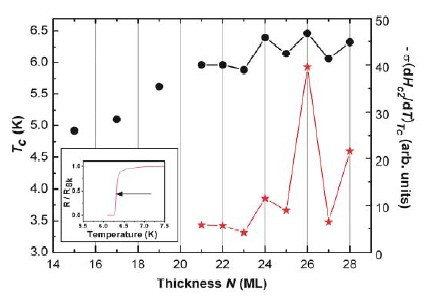The superconducting properties of ultrathin films are directly related to their thickness according to new experimental results from physicists in China and the US. Qi-Kun Xue of the Chinese Academy of Sciences in Beijing and co-workers have found that the superconducting transition temperature of thin films made of lead varies with the number of atomic layers in the film (Y Guo et al. 2004 Science 306 1915).

Modern electronic devices are often made of thin films. According to the “particle-in-a-box” model of quantum mechanics, electrons confined in a perfectly uniform thin film are quantized into discrete energy levels known as quantum well states. The formation of these states can modify the distribution of electrons near the Fermi level, and therefore have an influence on the physical and chemical properties of the film.
Xue and colleagues in Beijing, the University of Texas at Austin and the University of California at Berkeley grew crystalline films of lead on silicon substrates at 145 Kelvin. The films contained between 10 and 30 monolayers, although only films containing odd numbers of layers were stable below 22 monolayers. Xue and colleagues then cooled the films and measured the superconducting transition temperature, Tc, below which they lost their resistance to electric current.
The China-US team found that the transition temperature generally increased with film thickness up to 21 monolayers, before starting to oscillate, with films containing even numbers of monolayers having higher values of Tc than those containing odd numbers (see figure).
According to the Bardeen-Cooper-Schrieffer (BCS) theory of superconductivity, the transition temperature depends on the electron distribution at the Fermi level and on the interactions between electrons and phonons (vibrations of the crystal lattice). Xue and co-workers calculated that the density of states was higher near the Fermi level for films containing an odd number of layers, and argue that the oscillations in the transition temperature must therefore be closely related to the formation of quantum well states.
The results suggest that other properties of the films could also be modified by controlling this effect.



